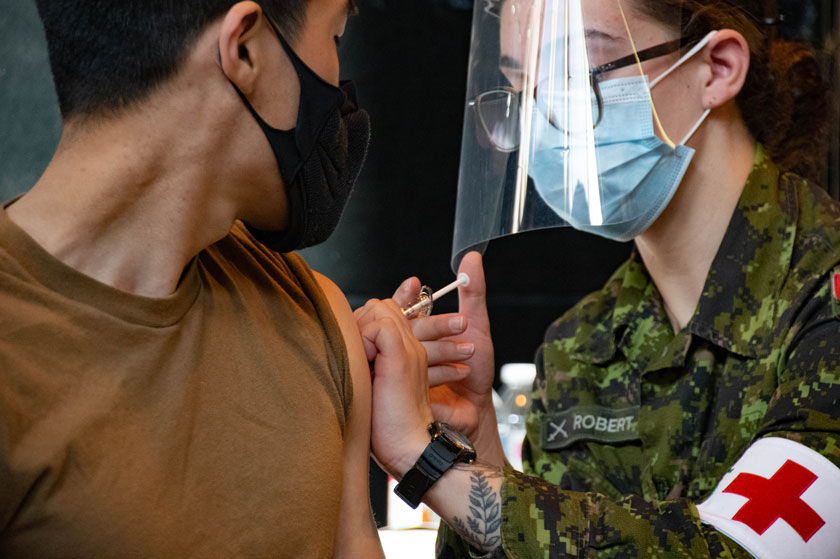Vaccinations – A brief history
October 12, 2022 - Defence Stories

Caption
If you’re considering whether or not to get your flu vaccine and COVID-19 booster this Fall, do so with the knowledge that vaccines work, they are safe, and they remain the most effective evidence-based preventive medicine tools to protect you and those around you.
Photo : MCpl Geneviève Lapointe, Canadian Forces Combat Camera, Canadian Armed Forces photo
Written by the Communicable Disease Control Programme, Directorate of Force Health Protection
As we enter the Fall, we expect a similar, predictable routine. Kids return to school, the days get shorter, and flu shots start getting advertised. Public health units, your family doctor’s office, and even the pharmacy in your local grocery store start sending out the message to encourage everyone to get vaccinated.
What’s the response to this? Many Canadians choose to receive their annual dose of influenza vaccine. They don’t love the idea of needles, but they decide to seek out the vaccine to help protect themselves and those around them from a miserable illness. The more people that are vaccinated, the more people in our community are protected against illness.
While thinking about getting immunized, you may wonder where vaccines came from. Let’s briefly review the history of vaccination, which all begins with Smallpox.
The Smallpox virus, with its two variants (Variola major and Variola minor), was a common human disease. It caused painful blistering all over the body, with associated bleeding, dehydration, permanent scarring, and, often times, death. Before there was a vaccine against it, around 80% of people are believed to have contracted Smallpox and, of these, 10% to 30% died from the disease.
Before a “modern” vaccine became available, it was a relatively common practice to protect previously uninfected children by rubbing scabs/pus obtained from recently infected individuals with mild disease into open wounds on the skin. Not a very pleasant picture – for sure – but it worked. Following several weeks of recovery, inoculated persons were protected against future infections, although rarely the illness that resulted from this practice could lead to severe disease and death, but at a lower rate of 1 in 1000, which was at least 100 times lower than the risk of death with uncontrolled infection.
Thankfully, an astute physician, Edward Jenner, made some observations in the late-1700s. He noticed that dairymaids did not appear to have scars on their faces, a feature that was common following Smallpox infection. Through a series of observations, he made a connection that the dairymaid’s exposure to Cowpox (which Jenner referred to as Variolae vaccinae), from milking the udders of infected cows, likely protected them against Smallpox infection. In essence, he concluded that because Cowpox and Smallpox are very similar (Cowpox causes much less severe disease) people infected with the cow version of the disease would be protected against the more severe Smallpox.
Dr Jenner tested his hypothesis on his gardener's son in 1796. He inoculated his son with pus/scabs from a dairymaid’s Cowpox sore on her hand (which she is believed to have contracted from a cow named Blossom). He then exposed his son to smallpox (you couldn’t do that today!) – he was protected. The inoculation with vaccinae, or vaccination as it would be later known, worked!
In 1798, he published a book on his findings, which is the first known book about vaccination. His approach spread quickly throughout Europe by 1800, and more globally over the ensuing decades. Within 200 years, Smallpox was eradicated from the world.
If not for the Smallpox vaccine, this disease may still be killing over 10% of the population. It would be reasonable to conclude that billions of lives have been saved thanks to this global vaccination effort.
The strategy of vaccination has been effectively used to prevent many other diseases, saving countless people from illness, suffering, and premature death, even though we haven’t be able to eradicate other vaccine-preventable diseases yet.
So, when you’re considering whether or not to get your flu vaccine and COVID-19 booster this Fall, do so with the knowledge that vaccines work, they are safe, and they remain the most effective evidence-based preventive medicine tools to protect you and those around you.
Oh, and for those of you who wonder what happened to Blossom, the cow, you may be interested to know that its hide has remained preserved in St George’s Hospital in London.
References
Bazin, Hervé, and Edward Jenner. The eradication of smallpox. London: Academic Press, 2000.
CDC - National Center for Emerging and Zoonotic Infectious Diseases (NCEZID), Division of High-Consequence Pathogens and Pathology (DHCPP) – History of Smallpox (you are now leaving the Government of Canada website). August 30, 2022.
Jenner, E. (1800). An inquiry into the causes and effects of the variolae vaccinae, a disease discovered in some of the western counties of England, particularly Gloucestershire, and known by the name of the cow pox. printed, for the author, by Sampson Low...; and sold by Law... and Murray and Hihghley.
Page details
- Date modified: